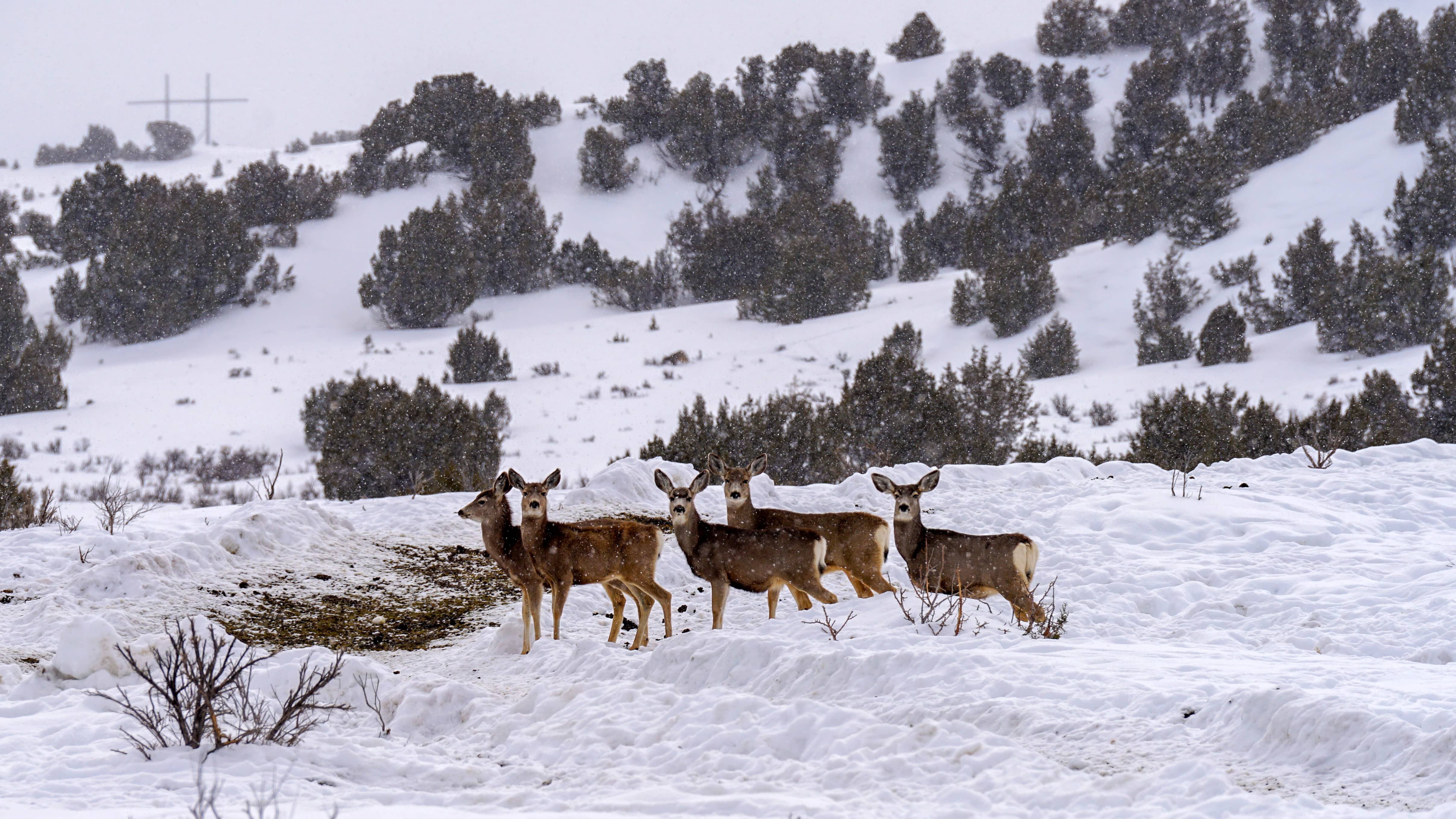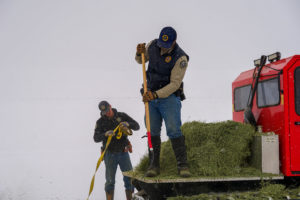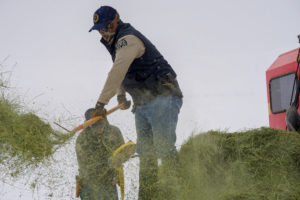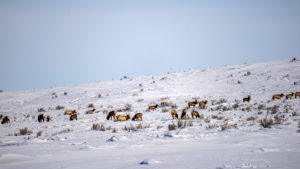
By Shannon Lukens. (Courtesy photos from R. Gonzales with Colorado Parks and Wildlife.)

Colorado Parks and Wildlife officers have been working with local ranchers and landowners on a bait operation that has helped bait wildlife away from potential conflict with livestock. Wildlife are getting into feed lines for cattle and horses, increasing the potential for elk to become aggressive as they compete for hay with livestock.


In late February, wildlife managers loaded up with hay at the CPW shop in Craig and headed to the Yampa River drainage near Maybell. Hay was placed at bait sites, to entice elk away from local ranches. Since the operation started, area wildlife staff have distributed over 1,000 tons of hay to about 100 landowners and ranchers in Craig, Maybell, Rangely, and the surrounding areas. Financial support has been provided by the Habitat Partnership Program State Council. Wildlife managers will continue to monitor the wildlife populations for the next 30-to-90 days as it will be a crucial time for wildlife survival.

Here is the full story from Colorado Parks and Wildlife; March 20, 2023.
Winter in the Northwest: The power collaboration
Winter has been tough for elk, deer and pronghorn in northwest Colorado. The phrase, “We’ve gotten a lot of snow,” is something often heard on the streets of Craig and other communities in the northwest corner of the state. Prolonged snow and extreme cold since October 2022 have made it difficult for wildlife to get much-needed food to survive the winter months. In some locations, wildlife is walking on 30 inches of hard-packed snow, making it impossible to access the food below. In an area known for its large residential elk herds and quality year-round habitat, hearing that another round of snow and cold was coming for the northwest part of the state was the last thing local staff wanted to hear.
As snow continued to fall, food became even more scarce. Ranchers and landowners began noticing an increase in the number of elk getting into feed lines set out for cattle, horses and other livestock. Something ranchers can’t afford to have happen. It’s an issue not just for the hay they eat, but also for the safety of their livestock. Elk are can be very aggressive and will stomp livestock and their newborns to get to the hay.
In January, Colorado Parks and Wildlife staff in the Craig area knew something needed to be done. As game damage claims continued to increase, local staff began working on a plan to address the ongoing concerns and reduce increasing conflict. On February 2, wildlife officers began a baiting operation to reduce conflict with livestock and game damage from elk.
Today, game damage has become a full-time job for district wildlife managers, and it’s not a one-size-fits-all approach for everyone. For district wildlife managers, this has meant sitting down with ranchers and landowners in their district to identify what the issues are and solutions to those issues. For some, the solution is to have CPW replenish the hay lost to elk. For others, it’s using hay provided by CPW to bait the elk away from their feed lines. In most cases, CPW is providing the hay, but the landowners are doing the work of creating and managing the bait lines. CPW has helped some landowners bait on their own by plowing snow, making it easier to access locations farther back on their land to prevent elk from walking back and forth between the bait line and their feed lines. CPW staff has been responsible for managing the bait line for a few landowners as well.
On a frigid morning in late February, local staff gathered at the CPW shop in Craig to load hay and equipment. After a quick meeting to go over that day’s plans, the team set off for the first of several deliveries for the day. When the team arrived at their first location along the Yampa River drainage near Maybell, the temperature read -9°F. Although you could see every breath they took as they prepared the snowcat and snowmobiles, the frigid temperatures were something they were used to after several days of below-zero temperatures. At this location, baiting operations will help five or six landowners in the area, baiting away around 200-250 head of elk.
Using the snowcat, District Wildlife Managers Seth Schwolert and Evan Jones made their way to the larger bait area where hay would be placed, enticing the elk to the area. Just over the hill, Assistant Area Wildlife Managers John Lambert and Mike Swaro used small bales of hay to create a line leading elk at a nearby ranch to the larger bait site where DWMs Schwolert and Jones were working. When the lines were set, the teams went back to the vehicles to load equipment, then to the shop to pick up the next load and head out once again.
This back-and-forth routine has become second nature for local staff. Days start early in the morning and end long after the sun has set, seven days a week. District wildlife managers are dedicated to ensuring they are doing everything they can to help the local community, even during another round of snow. Between deliveries, DWMs are calling and checking in with landowners and ranchers in their districts. Making sure they have everything they need or learning about new issues they or their neighbors may be dealing with. For Assistant Area Wildlife Manager Mike Swaro, that time is spent reaching out to local hay producers to see if they had hay available for purchase.
Since the baiting operation began in January, area wildlife staff have distributed over 1,000 tons of hay to around 100 landowners and ranchers in Craig, Maybell, Rangely, and surrounding areas. In addition to hay, CPW has worked closely with the local community to provide panels to protect hay stacks. From the start, CPW’s goal has always been to reduce the conflict with livestock by providing just enough to lead elk and deer away and encourage them to move on. The goal has never been to provide enough food to survive the winter.
This has been a community effort, not only Colorado Parks and Wildlife. Without the help and support of the ranchers, landowners, and community members, this would not be possible. Local staff are grateful for the support and patience from everyone.
This ongoing operation could not happen without financial support from the Habitat Partnership Program (HPP) State Council. As of March 15, the council has provided over $350,000 of funding for hay, deer pellets, paneling, and snow removal. Funding for HPP comes from the sale of big game licenses in Colorado.
While local staff have seen improvements in conditions for some locations, including the opening of south-facing slopes providing easy access to vegetation, local CPW staff can’t stress enough that we still have a long way to go. The next 30 – 90 days will be crucial for wildlife survival. Staff are monitoring the situation, but would like to remind everyone that, while they hope their efforts will help all animals in this area of the state, with over 50,000 year-round elk and deer herds spread across 10,200 square miles (6.5 million acres), it’s simply not possible.